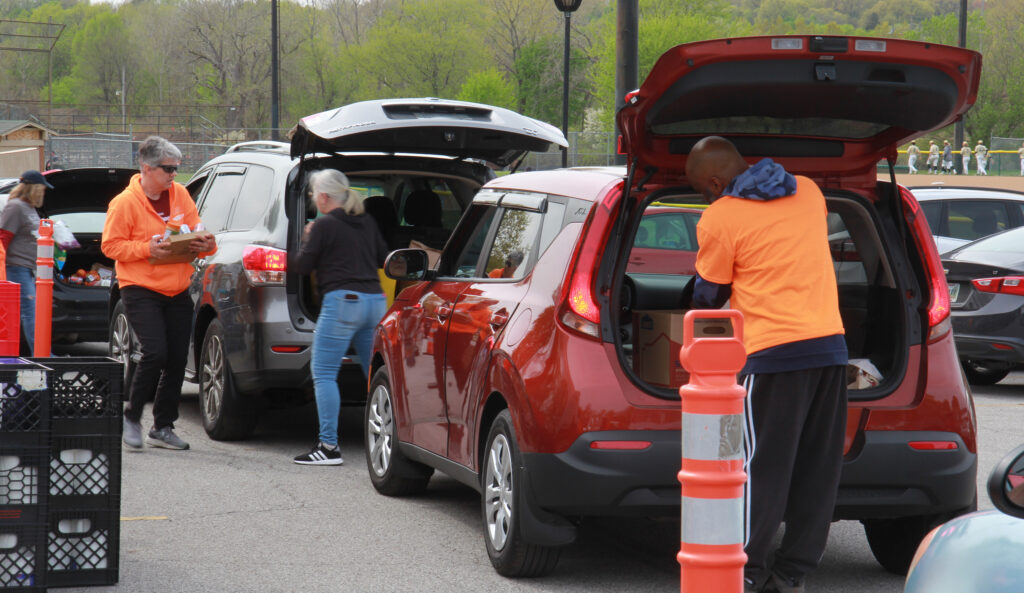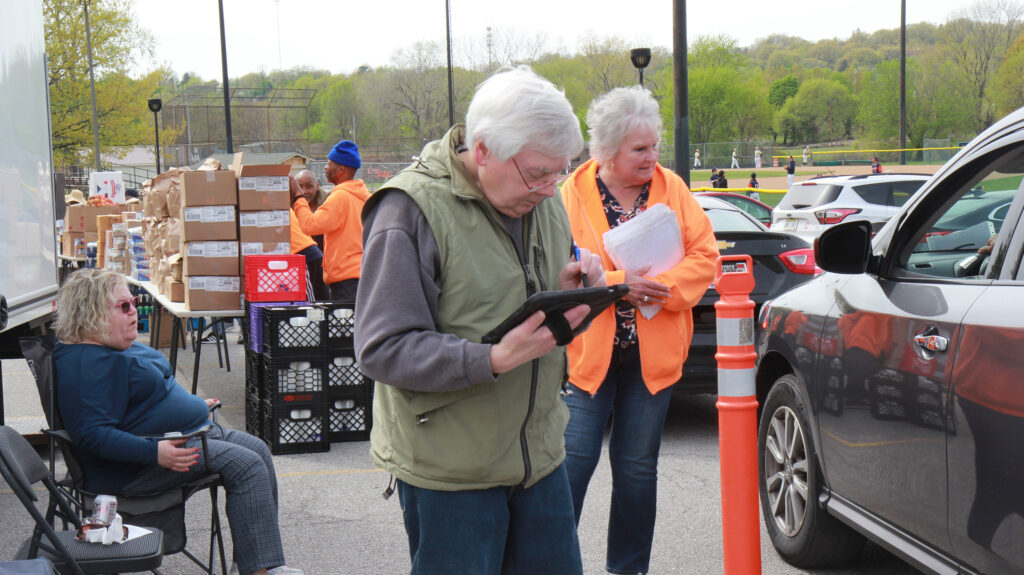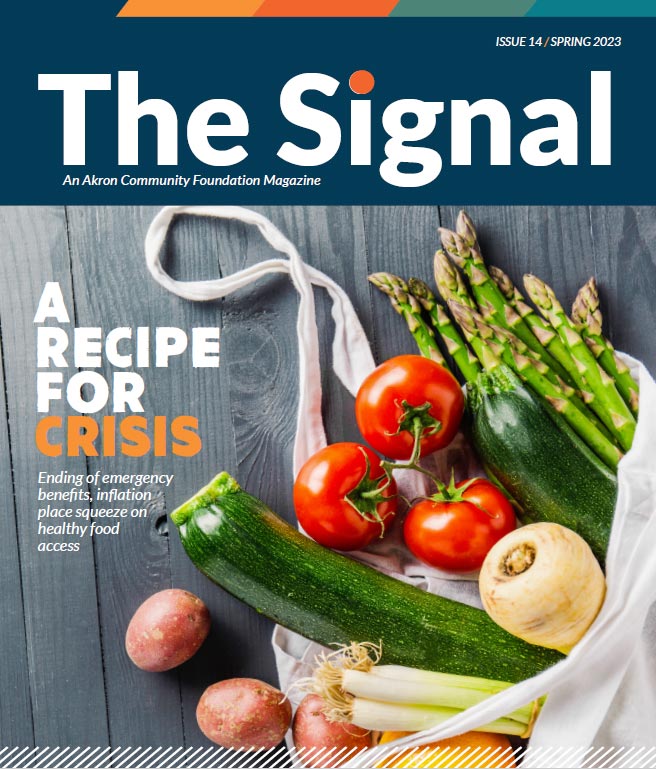A Recipe for Crisis
Ending of emergency benefits, inflation place squeeze on healthy food access
On a sunny April afternoon, dozens of cars line up in single file at Summit Lake Community Center in South Akron. Volunteers adorned in orange fill the trunks of the vehicles with boxes of happily received groceries and goods.
This food distribution site is one of five Akron locations served by the Good Samaritan Hunger Center's mobile food pantry. Unlike other food pantries, which primarily distribute food from a centralized location, Good Samaritan sets up operations in some of Akron's food deserts, or neighborhoods without a walkable full-service grocery store.
Since March 1, Good Samaritan and other food pantry operators have seen a steady increase in clients after the emergency Supplemental Nutrition Assistance Program (SNAP) benefits – established to help lessen the impact of the COVID-19 pandemic – came to an end. Across Ohio, this means a loss of more than $120 million in aid each month to more than 700,000 households, according to the U.S. Department of Agriculture. And in Summit County, an estimated 78,000 people will lose about $7.6 million in benefits monthly. Individually, this amounts to a reduction of about $90 per month per person.
"More people are coming to get food from us," said Michele Smith, executive director of Good Samaritan Hunger Center, which has seen an increase of up to 40 people per site since the emergency benefits ended. "And it's ticking upward."
Smith points out that existing food assistance guidelines require a recipient to spend one-third of their own income on food. "I don't know anybody living in restricted income guidelines that can afford to spend a third of their income on food," she added.
Linda Brown, treasurer of Sarah's House Inc., a food pantry she and her sisters started about 10 years ago, has seen an immediate increase in local food needs. "We are up about 50 families from last year," she said, adding that unlike other similar organizations, Sarah's House does not have the backing of a church or larger organization. "We're supported by only friends, family and neighbors."
"In Summit County, we served more than 57,000 visits to our pantry network from January through April," said Katie Carver Reed, vice president of the Akron-Canton Regional Foodbank. "During the same time period in 2022, our pantry network served about 42,000 visits. This demonstrates the increased need in the community, which we believe is a result of inflation and the loss of the SNAP benefits."
According to Reed, the food bank saw a 19% increase in the number of visits to its hunger-relief network by people seeking help – nearly 100,000 more visits than in previous years. In addition, the food bank saw a 31% increase in people served by its pantry network year over year.

Older Adults Affected
One population that was already struggling with food insecurity before some of these more recent developments is the community's aging adults.
"In March, we served 397 seniors. That means 25% of those we served in March were seniors," said Smith. "I'm so amazed when I find out the amount of money some of our seniors live on a month." She told the story of a former professional athlete who is now food insecure and is a monthly recipient of Good Samaritan's food distributions. "He and his wife come to the food pantry a couple times a month," she said. "That, to me, is tragic."
Brown, from Sarah's House, said she knows of seniors who only have about $18 a month to spend. The organization has added a senior program to its monthly offerings called Senior Community Circles, which includes games, prizes, guest speakers and a hot meal, along with distributions of food boxes tailored to older adults. These programs, she added, reach capacity nearly every time. "People should expect more for our community," she stressed. "We should do more for our seniors than we do."
Good Samaritan also has a senior box program that distributes more than 400 boxes each year, giving each recipient about 30 pounds of food per month.
"In the Akron-Canton Regional Foodbank's eight-county service area, approximately half the people seeking help with groceries are children under the age of 18 and senior citizens – our most vulnerable populations," said Reed.
Inflation Pressures
While the lifting of COVID-related food benefits was always the plan, other pressures have since mounted. Inflation, for example, has impacted nearly every facet of life, from gas and food prices to rent and building materials.
Food prices have risen 11%, according to the most recent USDA Consumer Price Index. As residents have seen a strain on their personal budgets, so too have the charities that are helping to get this food to the people they serve.
Each year, Good Samaritan hosts a turkey and trimmings giveaway, said Smith, who added that the cost of turkeys has gone up by 39%. In 2019, the turkeys cost the nonprofit $5,000; last year, they were $15,000. Thankfully, she said, the Akron-Canton Regional Foodbank helped absorb some of that cost. But this year, Good Samaritan expects to spend $13,000 on turkeys. "That's a lot, but we're committed to doing it," she said.
Inflation also has affected food pantry donations. "With the way the market has been up and down, when people use the residual incomes from their investment accounts and they see a loss rather than a gain, then they might not have the money to necessarily donate," said Smith. "That's tough."
Brown said Sarah's House has lost a reliable annual donor due to inflation and other economic strains.
Inflation and COVID also have spurred several community connectors and non-pantry service providers to step up and help address food insecurity, including churches, schools, individual philanthropists, and even animal shelters (see additional information at the end of this article).
Food Insecurity Misconceptions

Food insecurity is a nuanced and complex issue, going far beyond people not having food. One misconception, said Smith, is that people who are food insecure will always be food insecure.
"Sometimes their food insecurity is situational," she said. "A good portion of our (clients) come to us once a year. Often, somebody's hit some kind of a hard time, so they need to come to us so that they can make other ends meet."
Hunger is an invisible condition that affects people from all walks of life, said Reed. "Food insecurity is a challenge that impacts people from all backgrounds," she added. "Hunger can be felt by senior citizens trying to live on fixed incomes, families maneuvering the costs of child care and education, children receiving free and reduced meals at school, or rural residents navigating transportation barriers. It affects individuals temporarily out of work and those living with illness or disabilities, and it is disproportionately experienced by vulnerable populations such as communities of color or LGBTQIA+ individuals."
Another misconception is that there's not enough food, although a lot of good food is wasted or thrown away each day. Several area food pantries work with local food-based corporations to "rescue" some of this food for their clients before it gets discarded. For example, a number of Starbucks locations donate food to Good Samaritan.
Brown says Sarah's House receives donated goods from companies like Walmart or Amazon with non-food items for their clients. According to Brown, another mistaken belief is that food pantries have everything they need given to them, when most food pantries have to pay for the bulk of their food and other items needed to do business.
Foundation to Support Areas of Highest Need
On the horizon, the existing SNAP program is set to expire on Sept. 30 of this year, and some federal legislators are pushing for more stringent work requirements for benefits.
Smith says many people don't realize there are currently work requirements for these benefits. "Are you guaranteeing them a job to make that work requirement?" she asked, pointing out that many clients could face additional hurdles like discrimination and ageism while trying to meet these guidelines.
Later this year, Akron Community Foundation will help to address local food insecurity by making funding available through its Food Pantry Capacity Fund. Food pantries in roughly a dozen ZIP codes that were identified through Healthy Northeast Ohio's Food Insecurity Index as being the highest need, measured by both food access and economic household hardship, will be eligible for this funding.
In the meantime, there are many ways people can help the organizations included in this article, along with the dozens more throughout the area that are also feeling the pinch. One of the easiest ways to offer support is by making a monetary donation, but you can also contribute through your time or ties, either as a volunteer or by helping to connect the organizations to people and resources within your own personal network. Many food pantries are still struggling with the loss of volunteers due to the pandemic and because current volunteers are often stretched thin.
People can also donate used appliances. Like many food pantries, Sarah's House needs freezers and other storage-based items. "We always need storage for food," said Brown.
Smith said 97 cents of every dollar donated goes toward supporting Good Samaritan's programs.
Learn more about the organizations featured in this article by visiting their websites:
To donate to the Food Pantry Capacity Fund, visit akroncf.org/give/FoodPantryFund.
Addressing Food Insecurity in Unique Ways
In Summit County, food pantries take many shapes and forms, addressing both human and animal food insecurity.
The Celiac and Allergy Friendly Food Initiative, located in Cuyahoga Falls, is a gluten-free food pantry that serves allergy-friendly food to low-income families, typically serving 60 to 75 people a month. Program organizers point out that people with food allergies who are food insecure are often compelled to eat donated food that may make them sick. For more information, visit allergyfriendlyfood.org.
The Humane Society of Greater Akron offers a pet food pantry for animal owners. Since 2020, the organization has distributed 30,000 pounds of dry dog and cat food to nearly 3,500 pets in Summit County. For more information, visit summithumane.org/pet-food-pantry.
Food insecurity also affects local college students, as evidenced by the University of Akron's Campus Cupboard. The program offers nonperishable food and hygiene items to students who are food insecure. Visit uakron.edu/cupboard for more information.
Nonprofits in a range of service areas have set up food pantries to help meet the increasing needs of their clients. Akron Children's Hospital earlier this year set up a food pantry in the Considine Professional Building called the Food Farmacy, which provides food and household items to patients and their families in conjunction with the Akron-Canton Regional Foodbank. Visit akronchildrens.org for more information.
At the grassroots level, nonprofits like Himalayan Arts Language & Cultural Academy, halca.org, and the Karen Community of Akron, akronkaren.org, offer fresh food and perishables for their clients, many of whom are immigrants and refugees.

